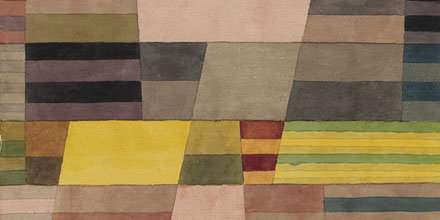Paul Klee
dal 28/2/2008 al 10/5/2008
Segnalato da
28/2/2008
Paul Klee
Bozar - Centre for Fine Arts, Bruxelles
The exhibition covers all aspects of Klee as a draughtsman, painter and philosopher. It explores his diverse forms of expression and his love of experiment. The approach taken is the influence of the performing arts on the work of Paul Klee. The titles of some works are direct references to the theatrical world, as are symbolic figures such as the tightrope walker, puppet and mask.

curated by Christine Hopfengart
This spring the Centre for Fine Arts is putting the spotlight on the work of the innovative, modernistic artist Paul Klee (1879 – 1940). His last solo exhibition in Belgium was back in1957 and so the Centre felt it was high time we renew our acquaintance with his oeuvre. Christine Hopfengart from the Zentrum Paul Klee in Bern has put the Paul Klee. Theatre here, there and everywhere exhibition on track with the help of guest curator Pierre Boulez, the celebrated conductor and composer.
The exhibition concept is unique in that it covers all aspects of Klee as a draughtsman, painter and philosopher. It explores his diverse forms of expression and his love of experiment.
The approach taken is the influence of the performing arts on the work of Paul Klee. Klee's interests ranged from opera to the humble puppet theatre and the hundreds of performances he attended provided him with a rich storehouse for his visual vocabulary. The titles of some works are direct references to the theatrical world, as are symbolic figures such as the tightrope walker, puppet and mask.
But above all the Swiss artist forged a link between theatre and life. He believed that theatre is as much a part of daily life as it is of the auditorium or circus tent. The people around him were his actors, daily occurrences his plays. He himself became the spectator, keeping a watchful eye on everything from a safe distance as if through a pair of opera glasses. He observed the world and looked for the theatrical in everyday life.
This mind-set enabled the artist to develop an unusual but clear poetic composition in which imagination and the commonplace merge. He created a certain musicality by means of graphic rhythms, colour similarities and linguistic signs, thus highlighting his affinity with the stage arts in all their manifestations.
The exhibition comprises some 220 works of art, mainly drawings and aquarelles but also some oil paintings. It consists of two main parts: Klee's passion for the performing arts and the musicality of his artworks seen by Pierre Boulez.
The second part of the exhibition was put together by guest curator Pierre Boulez. There is no doubt that his study of Klee's visual and theoretical work during his years as a lecturer at the Bauhaus plays a role in Boulez's musical composition. Boulez has never made any secret of his interest in Paul Klee, who as well as being an artist, was also a reasonably good violinist. In fact, in 1989 Boulez wrote a book entitled Le pays fertile, Paul Klee (published by Gallimard, reprinted 2008), an analysis of Klee's work in relation to contemporary music composition and music theory.
For the exhibition Boulez selected some 60 works which inspire him. This part is organized around the themes of music composition which also occur in the works of Klee: rhythm, heterophony and polyphony.
Centre for Fine Arts
Rue Royale/Koningsstraat 10 Brussels
Opening times
Tuesdays - Sundays, 10 - 18
Thursdays, 10- 21
Tickets € 9.00
€ 14.00: Combination Ticket Paul Klee and Treasures Old and New from Wallonia. A curious land.
This Combination Ticket also provides free access to all the Iceland on the Edge exhibitions.



